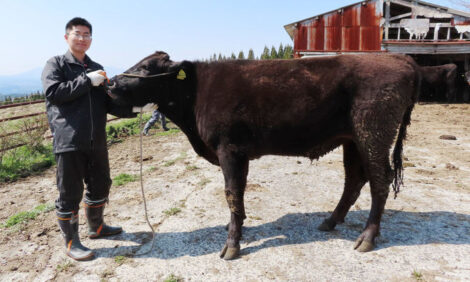



New study looks at impacts of a US ASF outbreak on swine, beef markets
Loss of pork export markets will also impact beef, poultry, corn and soy marketsDr. Dermot Hayes, an economist with Iowa State University, recently spoke with The Pig Site’s Sarah Mikesell concerning a pork checkoff-funded study of the potential impact of an African swine fever (ASF) outbreak on the US economy.
Impact of ASF on domestic supply
The study asks a simple question, ‘What would be the economic impact of discovering African swine fever in the US hog herd?’ said Dr. Hayes.
“If we discovered African swine fever in the United States, we would report it to our international customers,” said Dr. Hayes. “Their immediate response would be to restrict the importation of US pork. They would do that, regardless of whether we discovered it in Florida, North Carolina, or Iowa. It would be a knee jerk reaction, and we would lose our export markets.”
He said the US uses exports for two things.
“Exports add value to the carcass, by selling variety meats, such as the ears, tails, etc., into the markets where they're being valued. Exports add about $10 to the value of every carcass, and every carcass would lose that value if African swine fever was identified in the US,” said Dr. Hayes.
Second, on the muscle meat side, it's even worse. We’d need to get the American consumer to eat 25% more muscle meat which would be a significant challenge. It would require “enormous reductions in live hog values” and then to pass those savings to the American consumer so they would consider eating more pork.
“In the worst month, the worst impacted situation would generate a reduction in live hog values that would be more than 50%,” said Dr. Hayes. “In the first year, the swine industry would lose about $8 billion dollars and with the continued low prices, the second-year losses would be somewhat similar.”
“After that, if we do not get it under control and we do not get back into those export markets, the industry would need to be downsized,” he said. “We would have an industry that's 30% bigger than it needs to be. So, we would start shutting down hog barns, vet clinics and truck washes. The economic impact on the US economy would be huge – in the order of 60,000 jobs lost.”
However, if the industry can get back into export markets and can struggle through those first two years of losses, perhaps by hedges, insurance products or government support, the industry could begin to see light at the end of the tunnel, he explained. Then, perhaps the industry could keep veterinary clinics, truck washes, etc. open, and downsizing the industry would not be necessary.
“There are two things to keep in mind,” he said. “First, we have got to keep this horrible disease out of this country with biosecurity. Secondly, if we can’t keep it out of the US, we need to get ready for the outbreak of the disease.”
One way to prepare is called regionalization.
“Regionalization allows infected pigs identified in Florida, that we can prove didn't impact pigs in Iowa or any other part of the country, to be restricted while the pork in Iowa and other parts of the country can continue to be exported. This requires traceability, so we can identify where every pig moved from within the country,” he said. “By implementing regionalization and additional tracking, we can get back into the export markets quicker and we could avoid permanent damage to the industry.”
But unlike avian influenza in poultry, we move pigs all over the country. Thus, traceability challenges make it much harder for the pork industry than it would be for the poultry industry.
“But that is exactly the point, we need to be able to show that pigs from Iowa were not in contact with infected pigs from Florida and are safe to be moved,” he explained. “The way to do that is to have a good traceability program in place. The software for tracking has already been developed. It's called AgView, and producers are signing up for it.”
AgView is a free opt-in technology platform from the National Pork Board that assists producers of all sizes and types with the ability to provide disease status updates, pig movement data, and other data features to state and national animal health officials.
“I'm hopeful this study and other news events will encourage more producers to become better at biosecurity and tracing pigs,” he said.
Uses for data from study
“The study will be used to emphasize the financial disaster either for the two-year shutdown of exports and also what the results would be for 10-year shutdown,” said Dr. Hayes.
This is an update of a study that's 12 years old. Dr. Hayes did present the original results of the study to US customs officials. They were able to use this and other sources of information to obtain more funding for border security, and as a means to assess food coming into the US and to prevent affected food from entering the US.
“The National Pork Board began emphasizing preparedness after the first study because I think most of us were shocked at the financial damage the US economy would incur,” explained Dr. Hayes. “If we lose the US export market, we will have to downsize an enormous industry like pork.”
Downsizing the pork industry would impact beef, corn, soy
“If you somehow managed to get the American consumer to eat 25% more pork, there's not enough room on the plate for beef,” said Dr. Hayes. “During this scenario, pork looks cheap, and beef looks very expensive to the consumer. We’ll see people move away from beef to pork.”
The availability of inexpensive pork and beef in the U.S. domestic market would also lead to price reductions in competing proteins such as chicken, eggs, and cheese.
The way the market responds is the price of cattle falls by about 5%. It is likely that similar impacts would be identified across other protein species. However, the impact on grains is only about 1%, and that is counter intuitive.
“Imagine we're feeding 30% fewer pigs, we should experience a big impact on grain,” he said. “However, at the same time, we increase our production of poultry. Then we export more poultry, and other countries buy more of our corn and soybeans with which to produce replacement pork, domestically. So, the impact on corn and soybeans is very modest, only about down 1% or 2%.”
Scenario for market recovery
“During the first 30 days, we need to keep feeding the pigs even though the market has slowed and may not have a house to go to,” he said. “After that, as the pork industry depopulates, we're building up chickens in barns, feeding more of those for the domestic consumer or the export customer. In export markets like Japan, they buy more of our corn and soybeans and replace pork imports with their own domestic production.”
Carriquiry, M., A. Elobeid, and D.J. Hayes. 2023. "National Impacts of a Domestic Outbreak of Foot and Mouth Disease and African Swine Fever in the United States." Working paper 23-WP 650. Center for Agricultural and Rural Development, Iowa State University.




